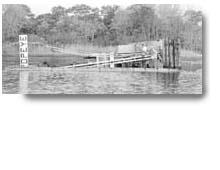Rain Blamed In Highway Death

The northeast storm that hung around on the weekend as though it were going to settle in forever caused more sting than pain, but was said to have resulted in an accident on a New Jersey Highway in which an East Hampton man died.
It rained - harder and for longer than almost anyone can remember. Four and a third inches were recorded in Bridgehampton on Saturday, and winds were steady at over 50 miles an hour with higher gusts for hours on end. Some neighborhoods were without power for up to 20 hours. An experimental dune restoration project in Quogue was washed away, and Ditch Plain in Montauk lost another four to six feet of dune.
Death On Highway
An East Hampton resident, Robert Giller, who was a prominent physician and author, was killed in an auto accident on the Garden State Parkway in New Jersey during the storm on Saturday. Witnesses said wind and rain caused the car to hydroplane. Dr. Giller's obituary appears in this issue.
The storm was slow-moving in coming up from the South, and it stalled between Northern New Jersey and New England after jet stream winds failed to steer it northward as is usual. More serious flooding here was avoided, however, because the storm left, abruptly, before high tide early Sunday.
Trees, including a few really large ones, branches, and wires were downed all over the East End. In East Hampton, residents of Springs went without power the longest - 2,745 of them for up to 20 hours.
One-Third Of Us
In all, 6,110 East Hampton residents lost power on Saturday during the height of the storm. Long Island Lighting Company crews restored most of the power by Sunday night.
Fortunately for the Hamptons International Film Festival, power was maintained at the United Artists movie house in the village. Festival-goers braved the weather both to get to the movie house and to attend the festival's weekend parties.
In Montauk, it was the ocean beach at Ditch Plain once again that took the hardest hit. According to Larry Penny, town director of natural resources, Ditch lost another four to six feet of bluff. He said that at Wainscott, "the other bellwether" for erosion, the beach "was shortened by about 50 percent. Some of the sand was redeposited on the back-shore.
Waterfront Damage
The Sag Harbor waterfront suffered more than other South Fork harbors. A 30-foot sailboat broke its mooring and came aground next to the North Haven bridge, and another large sailboat was beached near the South Ferry terminal on North Haven. In East Hampton, several small boats sank at their moorings as they did elsewhere in Southampton Town.
The Sag Harbor Fire Department reported that Spring, Plover, Redwood, and Bay Streets were flooded by rain and tide. The public A-Dock was underwater, and the town dock at Marine Park was damaged by the boats tied to it.
Southampton Town Police Lieut. Bob Eiberger, who is that town's emergency preparedness coordinator, said the worst flooding in that town was a result of overflowing sumps, one at the North Sea garbage transfer station, the other off Lewis Road in East Quogue.
At The Dump
In Southampton Town, 14,000 people were without electricity at one point or another. Most of the outages were caused by isolated problems rather than a single event, Lieutenant Eiberger said.
Six or seven cars were crushed under falling trees or branches in Southampton Town. Mr. Eiberger said Southampton saw minor erosion throughout town on the ocean side, although the usual trouble spots, Shinnecock at the east of Dune Road, and Westhampton Dunes on the west end, got off lightly.
Elsewhere on the Island, serious flooding occurred in Bayville, which felt the brunt of the storm during high tides. And, in Babylon, a 12-year-old boy was killed, having been crushed by a falling tree.
Wind and tide-driven waves wiped out the major dune restoration project at the Steinberg residence in Quogue.
Bonac Popeye, a work barge owned by Donald Tisdall, a marine contractor, went aground at the head of Three Mile Harbor near Soak Hides dreen on Saturday night and turned over, an event that prompted a small storm of its own.
In April, residents of the Hampton Waters community petitioned the East Hampton Trustees to forbid Mr. Tisdall from mooring his barges, Bonac Popeye and Bonac Tiki, outside of the mooring grid established for boats by the Trustees. They said they feared pollution. Several of the Trustees and Mr. Tisdall contended, however, that aesthetics, rather than concern for the environment, had prompted their discontent.
Of the incident Saturday, Bill Taylor, the town's senior harbormaster, said, "There was not enough oil to write home about." A light slick appeared around the barge on Sunday morning which, he said, was contained by a 200-foot absorbent boom put in place by the harbormasters and members of the town's hazardous materials team.
On Monday, Hampton Waters residents wasted no time in repeating their earlier warnings to town officials and the press. Mr. Tisdall's barge was righted on Tuesday with the help of Stuart Vorpahl, a bayman and former Town Trustee, who operates a work barge of his own.
Because of the storm's torrential rains, shellfish beds were closed all over Long Island by order of the State Department of Environmental Conservation, including all of South ampton's and East Hampton's.
Mr. Taylor reported on Tuesday night that water-quality tests made the day before had come back fairly free of coliform bacteria, adding that beds could be reopened as early as tomorrow.
The presence of the bacteria (associated with human and animal waste) in excess of Federal standards requires the immediate closing of shellfish grounds for seven days unless tests in the interim prove the water safe. Because the bacteria often enter bays and harbors via road runoff and flooded septic systems, shellfish beds are automatically put off-limits when it rains three inches or more.
